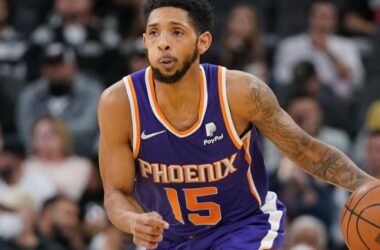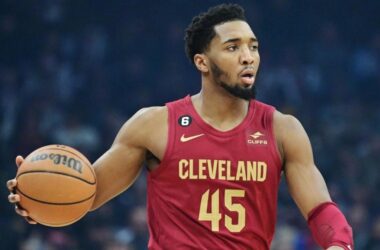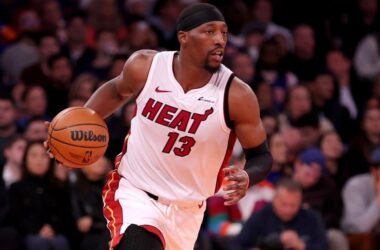The Sacramento Kings had the most efficient offense in NBA history last season when they averaged 118.6 points per 100 possessions. De’Aaron Fox and Domantas Sabonis are All-Stars, but their offensive duo is not perceived as the most talented in the league. So how did the Kings achieve such a remarkable feat?
One reason is the overall increase in efficiency across the league in recent years. Sacramento broke the record set by the previous highest-scoring team, the 2020-21 Brooklyn Nets, who in turn had broken the record set by the 2019-20 Dallas Mavericks. However, the Kings also excelled in several key areas that contributed to their offensive success:
- The Kings ranked sixth in the NBA in 3-point attempts per game (37.3).
- The Kings ranked seventh in the NBA in fast-break points per game (14.9).
- The Kings ranked seventh in the NBA in free throw attempts per game (25.1).
- The Kings ranked fourth in the NBA in passes per game (299.3) and third in potential assists (49.7).
- The Kings had one of the healthiest lineups in the NBA, with their starters missing fewer than 10 games throughout the season.
These statistics highlight the Kings’ focus on process rather than just outcomes. While they were effective in shooting from the line and beyond the arc, their success was largely attributed to their ability to generate shots and create opportunities through transition play and ball movement. Additionally, their overall health and continuity contributed significantly to their offensive prowess.
These factors will be considered in ranking this season’s NBA offenses. The rankings will take into account depth, durability, shot profiles, and the coaching track record to predict where each team will stand at the end of the season.
Denver Nuggets: The Nuggets have the advantage of having Nikola Jokic, widely regarded as the best offensive player in the league. Jokic has showcased remarkable durability, playing almost every game in every season. Additionally, the Nuggets are bringing back all five starters, providing a continuity advantage. Last season, they ranked in the top five in 3-point percentage, points in the paint, and fast-break points. The addition of rookie Julian Strawther, a sharpshooter, improves their bench depth.
However, the Nuggets may struggle with depth, particularly in the absence of Bruce Brown and Jeff Green. The offense also heavily relies on Jokic, and injuries to players like Jamal Murray and Michael Porter Jr. pose risks to their offensive success.
Milwaukee Bucks: The Bucks have a formidable offensive weapon in the pick-and-roll combination of Damian Lillard and Giannis Antetokounmpo. Their offensive strategy revolves around creating mismatches and exploiting the strengths of their star players. The team prioritizes scoring points, evident from their decision to start Malik Beasley. The Bucks also have a strong shooting depth, with most of their rotation players proficient from beyond the arc. The offensive post presence of Brook Lopez and the versatility of Khris Middleton as a third option further enhance their offense.
However, the Bucks face challenges due to the age of their key players. Lillard, Lopez, and Middleton are all in their thirties, and injuries could hamper their offensive efficiency. The performance of their backup point guard, Cameron Payne, is also a concern when he’s not playing alongside Devin Booker or Chris Paul.
Phoenix Suns: The Suns excel in mid-range shooting, with players like Kevin Durant and Devin Booker leading the way. The addition of Bradley Beal strengthens their shooting prowess. The team’s bench has notable shooters like Grayson Allen, Eric Gordon, and Damion Lee. Jusuf Nurkic’s skill as a screen setter contributes to their offensive success, and their transition game generates fast-break points.
However, the Suns struggle with restricted area shots, and their ability to consistently get to the rim is questionable. The impact of designated defenders like Josh Okogie and Keita Bates-Diop on spacing for star players is another area of concern. Furthermore, the durability of key players like Durant, Booker, and Nurkic could affect their offensive performance.
Sacramento Kings: The Kings continue to excel in various offensive aspects that contributed to their record-breaking season. They maintain their strengths in areas such as 3-point shooting, fast-break points, and free throw attempts. The addition of Chris Duarte and EuroLeague MVP Sasha Vezenkov improves their shooting efficiency. With a young roster capable of internal growth, the Kings retain their ability to generate offense through Fox’s speed and Sabonis’ screening.
However, the Kings might not replicate the same clutch performance as the previous season, and potential injuries could impact their offensive production. Additionally, their success is no longer a surprise, which means they may face tougher competition this season.
Dallas Mavericks: The Mavericks have a strong emphasis on ball handling and isolation plays. Luka Doncic and Kyrie Irving are exceptional shot creators. The team’s high volume of 3-point attempts is a notable aspect of their offense, and the addition of Seth Curry and Grant Williams enhances their shooting capabilities. However, their reliance on the top two players for shot creation raises questions about depth and the ability to generate offense beyond Doncic and Irving. The starting rookie center, Dereck Lively, may also present challenges, and issues regarding the health and performance of other key players like Jamal Murray need to be considered.
Golden State Warriors: The Warriors excel in 3-point shooting and prioritize transition play. Their bench rotation includes competent scorers like Gabe Vincent and Jonathan Kuminga. The team’s proficiency in passing and generating fast break points contributes to their offensive success. The presence of Chris Paul enhances their pick-and-roll game, and preseason performances suggest the potential for a strong bench unit.
On the other hand, the Warriors are relatively older and prone to injuries similar to the Suns. Their shot selection and spacing issues pose challenges, and the compatibility between Paul’s ball-holding tendencies and the team’s high-movement offensive style is yet to be determined. Furthermore, the performances of Thompson, Kuminga, and Moody, who are playing for contracts, could impact team chemistry.
Atlanta Hawks: The Hawks’ offense thrives in fast-break points, points in the paint, and 3-point attempts. The combination of Trae Young’s shot creation and Quin Snyder’s pick-and-roll offense design contributes to their offensive prowess. The presence of Dejounte Murray as a secondary creator with a unique mid-range game adds depth to the roster.
However, the Hawks heavily rely on Young’s floater and Murray’s mid-range game, which may limit their offensive diversity. The team lacks the shooting depth and talent of the Suns. The ability to consistently get to the rim and the impact of designated defenders on spacing are also areas for improvement. The durability of players like Clint Capela and the potential departure of players in trade rumors may affect team performance.
Indiana Pacers: The Pacers excel in transition offense and emphasize high-efficiency shots. The addition of Obi Toppin enhances their transition game, and the team ranks high in 3-point attempts and restricted area attempts. Rick Carlisle’s emphasis on efficient shot selection adds to their offensive strengths. However, their half-court offense is a weakness, as they ranked low in half-court points per play. The absence of a traditional late-clock shot creator poses challenges, and spacing issues may arise due to designated defenders. The impact of player development and contract situations also need to be considered.
New York Knicks: The Knicks excel in half-court offense and mid-range shooting. The team ranks high in points in the paint and has a tight lineup rotation, leading to consistent performance. However, their roster demands a small-ball approach, which may require adaptation from their coach. Spacing and ball movement are areas for improvement, and the reliance on Randle and Brunson for shot creation may limit offensive diversity.
20. Utah Jazz
The Jazz prioritize the right shots, ranking high in 3-point attempts and low in mid-range tries. The addition of John Collins addresses their previous shortcomings in paint scoring. However, their offensive success heavily relies on Collins making jumpers. Uncertainty in the backcourt and limited spacing due to the absence of reliable shooters may pose challenges. The performance of rookie guards and the impact of Talent Horton-Tucker’s limited shooting ability also need to be considered.
Miami Heat: The Heat’s offensive performance relies on improved shooting from the previous season. They run an egalitarian offense with a focus on ball handling and multiple players capable of creating shots. Bam Adebayo’s passing skills contribute to their offense, and the team ranks high in passes per game. However, without key shooters like Max Strus and Gabe Vincent, their 3-point shooting may decline. Averse to running, the Heat’s style may be better suited for the postseason. The health and age of Jimmy Butler and potential locker room issues may also impact their offensive performance.
22. Brooklyn Nets
The Nets generate transition offense through Ben Simmons, benefiting from their strong defense and turnovers. Mikal Bridges’ shot-making abilities provide additional scoring options. However, relying on Simmons’ health and performance is uncertain. Shaky shooters and spacing challenges with Simmons and Nic Claxton may limit offensive production. The use of Spencer Dinwiddie and Cam Thomas as shot creators raises concerns about relying on multiple players for offense.
26. Washington Wizards
The Wizards’ offensive success revolves around Jordan Poole’s scoring ability and the professional point guard skills of Tyus Jones. Kyle Kuzma excels in a spaced-out offensive system. However, the team’s offensive struggles are evident in their preseason game against the Knicks. Limited shooting, age, and health concerns pose challenges for the team.
30. Detroit Pistons
The Pistons’ offensive performance relies on the development of their young players and the potential All-Star talent of Cade Cunningham. However, concerns arise due to the team’s abundance of centers and poor shooting from certain players. The lack of shooting and scoring options from beyond the arc may affect offensive efficiency.




